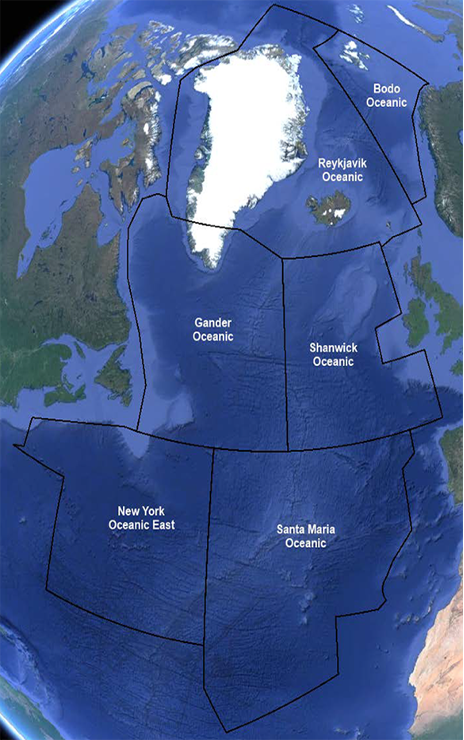Oceanic Area Control
The Reykjavik CTA is unique in that much of it is also designated as oceanic airspace. This page outlines the specific rules and procedures relevant to this airspace.
As of 20th March 2024, aircraft no longer require oceanic clearance to enter the Reykjavik OCA. Updated procedures for oceanic entry are detailed below.
The Nattrak website has not yet been updated for OCL removal. Therefore, controllers must not use Nattrak until officially notified that it has been updated.
Due to software limitations, it is not possible to use the Hoppies CPDLC platform to process RCL messages.
Oceanic Airspace
Within the Reykjavik CTA, all controlled airspace outside of the Icelandic Domestic Area is considered oceanic airspace. This airspace is designated the Reykjavik Oceanic Area (OCA).
Because the Reykjavik ACC (Area Control Centre) is responsible for the Reykjavik OCA, it is also referred to as the Reykjavik OAC (Reykjavik Oceanic Area Control Centre.) "Reykjavik ACC" and "Reykjavik OAC" are generally interchangeable terms, at least for VATSIM purposes.
The Reykjavik OCA is one of six oceanic areas that make up the North Atlantic (NAT) oceanic airspace. The other five are Gander, Shanwick, New York, Santa Maria, and Bodo OFIR (Oceanic FIR).
NAT Tracks
The NAT airspace uses a system of organized tracks called the North Atlantic Organized Track System (NAT OTS) to regulate traffic crossing the ocean. While usually remaining in Shanwick & Gander OCAs, the tracks do occasionally enter the Reykjavik OCA.
For information regarding the NAT track system, read this guide published by the Gander OCA on VATSIM. (Ignore the sections on the Tango routes & Concorde tracks, as they are not relevant to the BIRD OCA.)
Oceanic Entry
Aircraft entering the Reykjavik OCA must have an IFR clearance. VFR aircraft are not permitted in oceanic airspace (which is Class A); they must either fly below controlled airspace (FL55 over the ocean), or obtain IFR clearance.
Aircraft entering the Reykjavik OCA from domestic airspace, or from oceanic airspace where ATC is offline, shall report all the information below to Reykjavik OAC prior to oceanic entry:
- Oceanic Entry Point (OEP) – i.e., first waypoint in oceanic airspace
- ETA for the OEP
- Mach Number
- Requested Flight Level – i.e., intended flight level at oceanic entry
- The maximum Flight Level which can be attained at the OEP
Even though there are no more "oceanic clearances," the above is still called a "request for clearance" (RCL) message (yes, it is rather confusing...)
Aircraft must transmit the RCL message no earlier than 25 mins before oceanic entry (but still prior to oceanic entry itself.) This may be done via voice (or in the near future, via the Nattrak website, once it has been updated.)
Reykjavik OAC shall acknowledge the aircraft's RCL message, and either:
- Instruct the aircraft to "fly current flight plan" (i.e., follow the existing flight plan, as previously cleared & loaded into the FMS, with no changes.)
- Amend the flight plan (i.e., instructing the aircraft to fly a different routing, flight level, Mach speed, etc.) as necessary to ensure traffic separation (or to fix any issues in the original flight plan.)
For aircraft entering the Reykjavik OCA from oceanic airspace where ATC is online, the aircraft does not need to provide a new RCL message. Reykjavik OAC will generally obtain the necessary information electronically, via the tag transfer from the transferring oceanic ATC unit.
Aircraft may fly in ECON (Cost Index) mode for optimal fuel efficiency – i.e., they may deviate by up to ±0.02 Mach from the Mach number originally reported to ATC without prior permission. If they deviate by >0.02 Mach from the originally reported Mach number, they must notify ATC. Controllers may also instruct aircraft to fly a fixed Mach number if required for separation.
Voice Phraseology
Example 1: Fly current flight plan (no changes to flight plan required)
🧑✈️ Reykjavik Control, ICE123, request for clearance.
🎧 ICE123, go ahead.
🧑✈️ ICE123, oceanic entry point is VALDI, estimating VALDI at 1234z, Mach .79, FL340, maximum flight level 360.
🎧 ICE123, roger, fly current flight plan.
🧑✈️ Fly current flight plan, ICE123.
Example 2: Amended clearance
If the aircraft's flight plan must be amended, instead of "fly current flight plan," Reykjavik OAC shall use the phrase "amended [speed/route/level] clearance," followed by the details of the amended clearance. E.g.,
🧑✈️ Reykjavik Control, ICE456, request for clearance.
🎧 ICE456, go ahead.
🧑✈️ ICE456, oceanic entry point is IPTON, estimating IPTON at 1235z, Mach .79, FL340, maximum flight level 360.
🎧 ICE456, amended route and speed clearance, after IPTON cleared direct ING, then direct NASBU, maintain Mach .76.
🧑✈️ After IPTON cleared direct ING then direct NASBU, maintain Mach .76, ICE456.
🎧 ICE456, readback correct.
Controllers may also issue a conditional instruction (e.g., cross a waypoint, climb/descend to a level, etc.) "at," "at or before," or "at or after" a certain time, to ensure traffic separation. E.g.,
🎧 ICE456, cross IPTON at or after 1236z.
If an aircraft is flying via a NAT track, Reykjavik OAC must also verify the current TMI number with the aircraft prior to oceanic entry (see the Gander OCA guide linked abive if unfamiliar with TMI numbers.)
Nattrak ("CPDLC")
– TO BE CONFIRMED | DO NOT USE NATTRAK UNTIL UPDATED –

